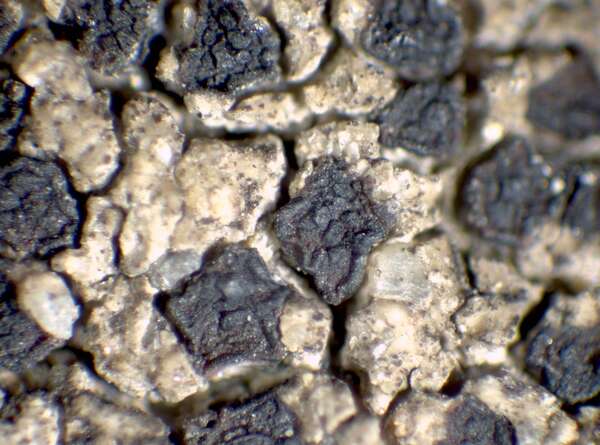Sarcogyne canasiacensis (Hue) H. Magn.
in Rabenhorst's Krypt.-Fl., 2nd ed., 9, 5.1: 57, 1935. Basionym: Lecanora scabra var. canasiacensis Hue - J. Bot., Paris 5: 278, 1891.
Synonyms: Polysporina canasiacensis (Hue) Cl. Roux; Polysporina lapponica auct., non (Ach. ex Schaer.) Degel.
Description: Thallus crustose, episubstratic, pale grey-brown, usually starting the life-cycle on the thalli of crustose lichens. Apothecia lecideine, sessile, black to brownish black, round and convex to irregular, 0.25-0.5 mm across, dispersed or clustered, the largest ones usually forming deeply fissured agglomerations, with a black, irregularly and incompletely carbonized, often gyrose disc and a black, fissured, rough margin. Proper exciple carbonized in outer part, yellowish to colourless within; epithecium conglutinated in a dark brownish or reddish brown gel; hymenium colourless to to yellowish-orange, 75-150 µm high, often divided by sterile columns of conglutinated hyphae, the hymenial gel hemiamyloid, K/I+ light blue fading to light red; paraphyses coherent, 1-1.5 µm thick at base, septate, hardly expanded at apex; hypothecium colourless. Asci 200-300-spored, clavate to subcylindrical, strongly thickened at apex, the apical dome K/I-, the outer coat K/I+blue. Ascospores 1-celled, hyaline, narrowly ellipsoid to subcylindrical, (2.5-)4-5.5(-6) x 1-1.5 μm. Photobiont chlorococcoid. Spot tests: thallus K-, C-, KC-, P-, UV-. Chemistry: without lichen substances.
Growth form: Crustose
Substrata: rocks
Photobiont: green algae other than Trentepohlia
Reproductive strategy: mainly sexual
Commonnes-rarity: (info)
Alpine belt: absent
Subalpine belt: extremely rare
Montane belt: rare
Dry submediterranean belt: rather rare
Humid submediterranean belt: rather rare
Padanian area: absent
pH of the substrata:
1 2 3 4 5
Solar irradiation:
1 2 3 4 5
Aridity:
1 2 3 4 5
Eutrophication:
1 2 3 4 5
Poleotolerance:
0 1 2 3
Altitudinal distribution:
1 2 3 4 5 6
Rarity
absent
extremely rare
very rare
rare
rather rare
rather common
common
very common
extremely common
Loading data...
Occurrence data
Predictive map
Growth form: Crustose
Substrata: rocks
Photobiont: green algae other than Trentepohlia
Reproductive strategy: mainly sexual
Commonnes-rarity: (info)
Alpine belt: absent
Subalpine belt: extremely rare
Montane belt: rare
Dry submediterranean belt: rather rare
Humid submediterranean belt: rather rare
Padanian area: absent
pH of the substrata:
| 1 | 2 | 3 | 4 | 5 |
Solar irradiation:
| 1 | 2 | 3 | 4 | 5 |
Aridity:
| 1 | 2 | 3 | 4 | 5 |
Eutrophication:
| 1 | 2 | 3 | 4 | 5 |
Poleotolerance:
| 0 | 1 | 2 | 3 |
Altitudinal distribution:
| 1 | 2 | 3 | 4 | 5 | 6 |
Rarity
absent
extremely rare
very rare
rare
rather rare
rather common
common
very common
extremely common
Loading data...
Occurrence data
Predictive map







